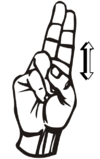Definify.com
Webster 1913 Edition
U
U
(ū)
, the twenty-first letter of the English alphabet, is a cursive form of the letter V, with which it was formerly used interchangeably, both letters being then used both as vowels and consonants. U and V are now, however, differentiated, U being used only as a vowel or semivowel, and V only as a consonant. The true primary vowel sound of U, in Anglo-Saxon, was the sound which it still retains in most of the languages of Europe, that of long oo, as in tool, and short oo, as in wood, answering to the French ou in tour. Etymologically U is most closely related to o, y (vowel), w, and v; as in two, duet, dyad, twice; top, tuft; sop, sup; auspice, aviary. See
See Guide to Pronunciation , §§ 130-144.V
, also O
and Y
. Webster 1828 Edition
U
U
is the twenty first letter and the fifth vowel in the English Alphabet. The sound seems to be nearly that of eu, shortened and blended. This sound however is not precisely that of eu or yu, except in a few words, as in unite, union, uniform; the sound does not begin with the distinct sound of e, nor end in the distinct sound of oo, unless when prolonged. It cannot be well expressed in letters. This sound is heard in the unaffected pronunciation of annuity, numerate, brute, mute, dispute, duke, true, truth, rule, prudence, opportunity, infusion.Some modern writers make a distinction between the sound of u, when it follows r, as in rude, truth, and its sound when it follows other letters, as in mute, duke; making the former sound equivalent to oo; rood, trooth; and the latter a diphthong equivalent to eu or yu. This is a mischievous innovation, and not authorized by any general usage either in England or the United States. The difference, very nice indeed, between the sound of u in mute, and in rude, is owing entirely to the articulation which precedes that letter. For example, when a labial precedes u, we enter on its sound with the lips closed, and in opening them to the position required for uttering u, there is almost necessarily a slight sound of e formed before we arrive at the proper sound of u. When r precedes u, the mouth is open before the sound of u is commenced. But in both cases, u is to be considered as having the same sound.
In some words, as in bull, full, pull, the sound of u is that of the Italian u, the French ou, but shortened. This is a vowel.
U
has another short sound, as in tun, run, sun, turn,rub.
Definition 2025
Ü
Ü
Composition: U [U+0055] + ̈ [U+0308]
| ||||||
|---|---|---|---|---|---|---|
See also: Appendix:Variations of "u"
Translingual
Letter
Ü upper case (lower case ü)
See also
- (Latin script): Aa Bb Cc Dd Ee Ff Gg Hh Ii Jj Kk Ll Mm Nn Oo Pp Qq Rr Sſs Tt Uu Vv Ww Xx Yy Zz
- (Variations of letter U): Úú Ùù Ŭŭ Ûû Ǔǔ Ůů Üü Ǘǘ Ǜǜ Ǚǚ Ǖǖ Űű Ũũ Ṹṹ Ųų Ūū Ṻṻ Ủủ Ȕȕ Ȗȗ Ưư Ứứ Ừừ Ữữ Ửử Ựự Ụụ Ṳṳ Ṷṷ Ṵṵ Ʉʉ ᵾ ᶙ ᴜ Uu Ꜷꜷ Ȣȣ ᵫ
- (Letters using umlaut or diaresis sign): Ää Ǟǟ Ëë Ḧḧ Ïï Ḯḯ N̈n̈ Öö Ȫȫ Ṏṏ ẗ Üü Ǘǘ Ǚǚ Ǜǜ Ǖǖ Ṻṻ Ṳṳ Ẅẅ Ẍẍ Ÿÿ
Azeri
Letter
Ü upper case (lower case ü)
See also
- (Latin script letters) hərf; Aa, Bb, Cc, Çç, Dd, Ee, Əə, Ff, Gg, Ğğ, Hh, Xx, Iı, İi, Jj, Kk, Qq, Ll, Mm, Nn, Oo, Öö, Pp, Rr, Ss, Şş, Tt, Uu, Üü, Vv, Yy, Zz
ü
ü
Composition: u [U+0075] + ̈ [U+0308]
| ||||||
|---|---|---|---|---|---|---|
See also: Appendix:Variations of "u"
Translingual
Letter
ü lower case (upper case Ü)
See also
- (Latin script): Aa Bb Cc Dd Ee Ff Gg Hh Ii Jj Kk Ll Mm Nn Oo Pp Qq Rr Sſs Tt Uu Vv Ww Xx Yy Zz
- (Variations of letter U): Úú Ùù Ŭŭ Ûû Ǔǔ Ůů Üü Ǘǘ Ǜǜ Ǚǚ Ǖǖ Űű Ũũ Ṹṹ Ųų Ūū Ṻṻ Ủủ Ȕȕ Ȗȗ Ưư Ứứ Ừừ Ữữ Ửử Ựự Ụụ Ṳṳ Ṷṷ Ṵṵ Ʉʉ ᵾ ᶙ ᴜ Uu Ꜷꜷ Ȣȣ ᵫ
- (Letters using umlaut or diaresis sign): Ää Ǟǟ Ëë Ḧḧ Ïï Ḯḯ N̈n̈ Öö Ȫȫ Ṏṏ ẗ Üü Ǘǘ Ǚǚ Ǜǜ Ǖǖ Ṻṻ Ṳṳ Ẅẅ Ẍẍ Ÿÿ
Azeri
Letter
ü lower case (upper case Ü)
See also
- (Latin script letters) hərf; Aa, Bb, Cc, Çç, Dd, Ee, Əə, Ff, Gg, Ğğ, Hh, Xx, Iı, İi, Jj, Kk, Qq, Ll, Mm, Nn, Oo, Öö, Pp, Rr, Ss, Şş, Tt, Uu, Üü, Vv, Yy, Zz
Portuguese
Pronunciation
- (Diaeresis) IPA(key): /w/
- (German loanwords) IPA(key): /i/
Symbol
ü (lower case, upper case Ü)
Usage notes
This letter is used to indicate diaeresis in <qu> and <gu> before <i> and <e> (e.g. freqüência, aqüífero, agüentar, lingüiça). It has been made obsolete by the reform of 1990, but could still be used until 31st of December 2012.
It is also used in words derived from borrowings, such as mülleriano, from German Müller (this usage isn't affected by the reform).
Spanish
Pronunciation
- IPA(key): /w/
Symbol
ü (lower case, upper case Ü)
Usage notes
Used to indicate diaeresis in <gu> before <i> and <e> (e.g. paragüero, pingüino).
Turkish
Letter
ü (lower case, upper case Ü)
See also
- (Latin script letters) harf; Aa, Bb, Cc, Çç, Dd, Ee, Ff, Gg, Ğğ, Hh, Iı, İi, Jj, Kk, Ll, Mm, Nn, Oo, Öö, Pp, Rr, Ss, Şş, Tt, Uu, Üü, Vv, Yy, Zz
Noun
ü
See also
- (Latin script letter names) harf; a, be, ce, çe, de, e, fe, ge, yumuşak ge, he, ı, i, je, ke, le, me, ne, o, ö, pe, re, se, şe, te, u, ü, ve, ye, ze (Category: tr:Latin letter names)
